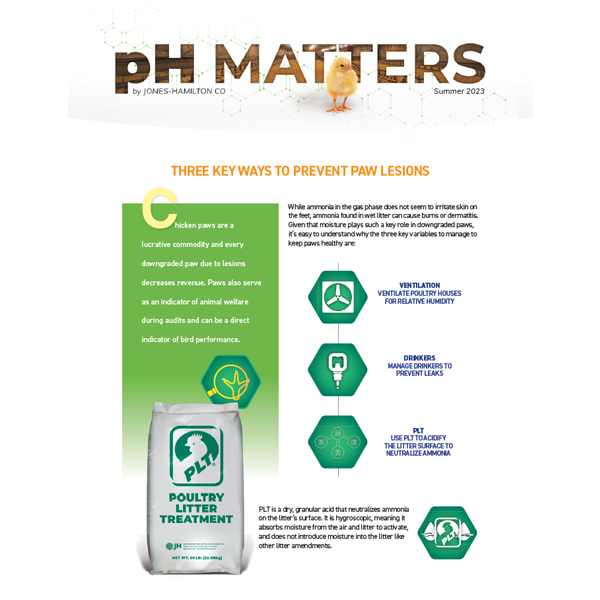Three Key Ways to Prevent Paw Lesions
Chicken paws are a lucrative commodity and every downgraded paw due to lesions decreases revenue. Paws also serve as an indicator of animal welfare during audits and can be a direct indicator of bird performance.
While ammonia in the gas phase does not seem to irritate skin on the feet, ammonia found in wet litter can cause burns or dermatitis. Given that moisture plays such a key role in downgraded paws, it’s easy to understand why the three key variables to manage to keep paws healthy are:

Ventilation
Ventilate poultry houses for relative humidity

Drinkers
Manage drinkers to prevent leaks

PLT – Poultry Litter Treatment
Acidify the litter surface to neutralize ammonia

PLT is a dry, granular acid that neutralizes ammonia on the litter’s surface. It is hygroscopic, meaning it absorbs moisture from the air and litter to activate, and does not introduce moisture in to the litter like other litter amendments.
Manage Moisture for Healthy Paws
The formation of liquid ammonia at the litter surface occurs anywhere there is even the least bit of damp litter. The stickiness and moistness of the caking present in the houses seems to play the predominant role in paw damage.
Common culprits are small wet spots under the drinkers (commonly referred to as donuts) and caked areas along the sidewalls. Anything that makes the litter tacky and sticky, even if only in the top few millimeters of the litter, will cause the litter to stick to the chick’s foot and begin to damage it. When newly hatched chicks step onto those damp areas, the damp litter sticks to their feet and ammonia in the litter begins to erode the skin.


Visible paw lesions can be evident by day 7 and continue to worsen over time. Even if the litter dries out, the lesions do not tend to heal. Surprisingly, in houses with dry litter and good relative humidity control, the bottoms of the birds’ feet are very clean and it is unusual to find a footpad lesion on a bird with clean feet. The adherence of wet litter to the bird’s foot at a young age seems to be the key to damaging the paws. This is consistent with literature reports of decreased paw quality in houses with higher relative humidity and moisture at the litter surface.
Houses with no or low ammonia at bird level can still have a substantial percentage of poor paws if the litter is damp or tacky. This is most often seen in brand new houses or on new litter where the relative humidity is high even though the ammonia is not, and litter slicking occurs. At the same time, houses with dry litter except for quarter size donuts under the drinkers due to leaky nipples or sticky litter from high relative humidity will still have a substantial number of birds with paw lesions.
If you are struggling with profit losses due to paw downgrades, contact Jones-Hamilton for a litter assessment.

